ap bio : unit 6 cram sheet (copy)
Author Notes
HEYYYYY welcome to my cram sheet on unit 6: gene expression and regulation, my fav unit out of them all !! just note that this cram sheet’s info is based off of the AP daily videos as well as my own notes from teacher lectures :DD
like this cram sheet? you should check out my other ones at my profile!!
external resources similar to following topic will be linked at the end :)
╭ Other Resources :
:: TO BE ADDED - mcq progress check﹒﹒already took the mcq? “take it again” in flashcard form with an additional explanation of the answer! (frm urs truly :D )
:: cararra ﹒﹒ 35 min ap bio review video based from the campbell biology 11th edition textbook!
:: khan academy ﹒﹒the entire unit 6 course from khan academy!!
:: fiveable ﹒﹒ reviews unit 6 with articles and quizzes for you to practice your knowledge on!
﹙✦﹚﹒abbreviations will be used in this guide (only a lil bit)
﹙6.1 - DNA and RNA Structure﹚
✦﹒deoxyribonucleic acid (DNA) (and sometimes RNA) is the primary source of heredity material
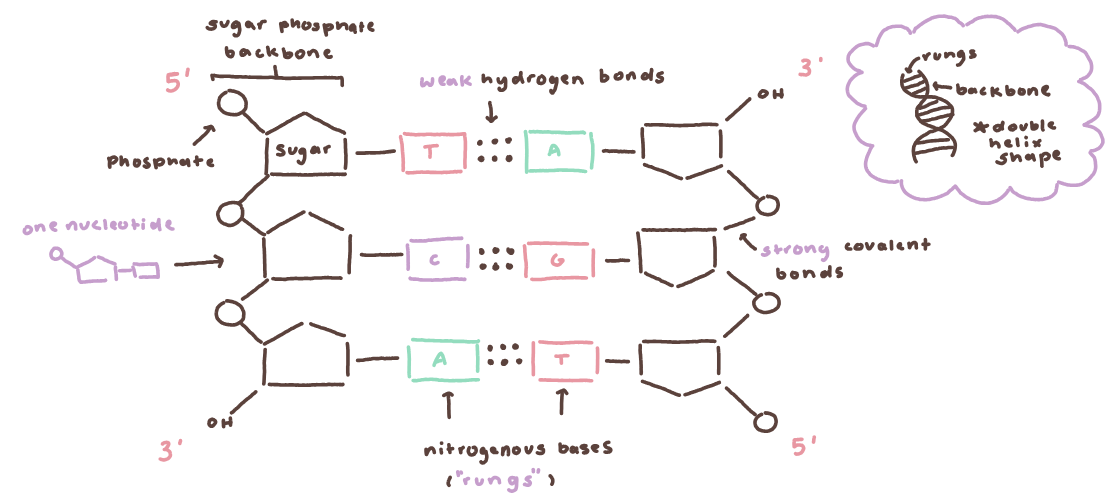 visual of DNA’s structure. the sugar is deoxyribose sugar
visual of DNA’s structure. the sugar is deoxyribose sugar
anti parallel, where ONE strand is 5’-3’ and another is 3’-5’
goes in different directions
nitrogenous bases are either pyrimidines or purines
pyrimidines (thymine, cytosine) are single ringed, and pair with a purine (adenine, guanine), which is double ringed
base pair memorization tip: apples in trees, cars in garage
double helix (staircase) shape, made up of nucleotides
✦﹒DNA and ribonucleic acid (RNA) have many structural differences
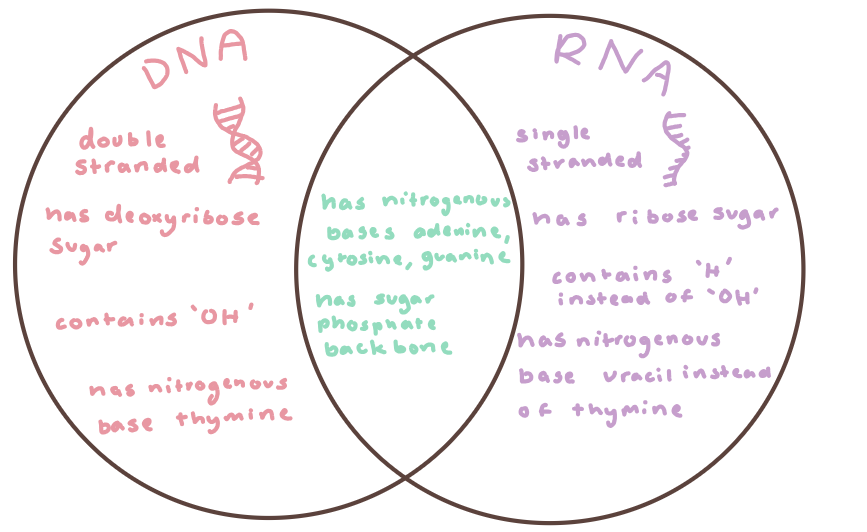
main difference is that RNA has uracil that bonds with adenine instead of thymine in DNA!
✦﹒prokaryotes (and sometimes eukaryotes) have plasmids that carry their genetic material
plasmids are small extra chromosomal, double stranded DNA molecules
typically circular in prokaryotes, located in the cytosol
eukaryotes have linear DNA at the nucleus
prokaryotes have a smaller genome than eukaryotes
╭ Other Resources :
:: amoeba sisters ﹒﹒ video comparing DNA and RNA!
﹙6.2 - Replication﹚
✦﹒replication ensures the continuity of genetic info
it is semi conservative, process results in two DNA molecules that are both made up of a complementary strand and the template (original) strand
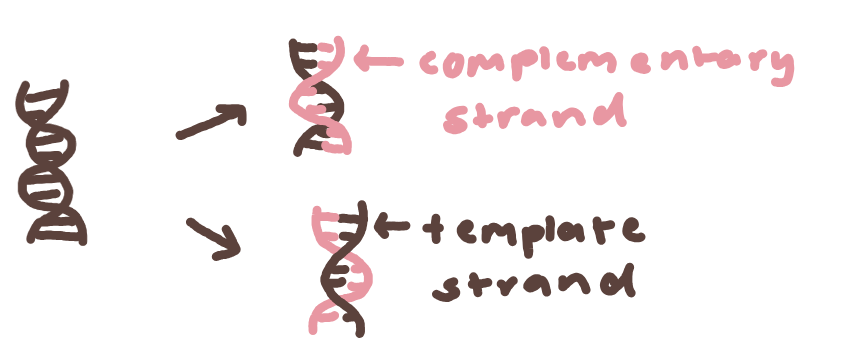
✦﹒replication occurs in mitosis and meiosis, creating a full set of chromosomes to put in new daughter cells
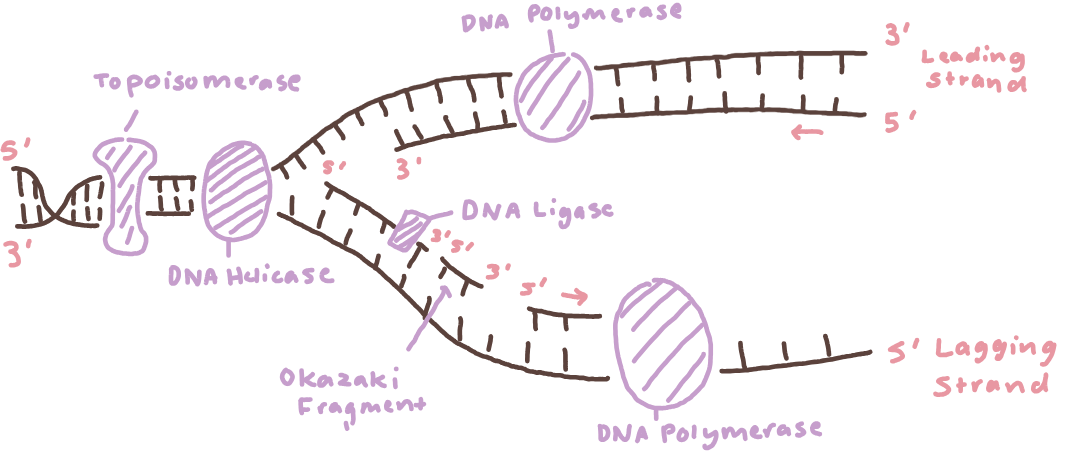 visual of the replication process. see info on components below.
visual of the replication process. see info on components below.
lagging strand is synthesized discontinuosly in fragments (known as okazaki fragments)
leading strand is synthesized continuously
✦﹒various enzymes help perform replication—
topoisomerase - relaxes the supercoil at the replication fork
replication fork - the area the 2 strands separate
DNA helicase unwinds (unzips) the DNA strand
DNA polymerase synthesizes new strands (the builder)
needs RNA primers to START synthesis
attaches to 3’ of template strand
builds strand in 5’-3’ direction
DNA ligase joins the okazaki fragments together on the lagging strand (works as “glue”!)
✦﹒directionality influences the process the replication
the 5 prime end (5’) has a phosphate terminus at the end
the 3 prime end (3’) has a hydroxyl terminus at the end
╭ Other Resources :
:: amoeba sisters ﹒﹒ DNA replication explained by amoeba sisters :)
:: crashcourse ﹒﹒ crash course video where Hank explains the replication of DNA!
:: DNA learning center ﹒﹒ video visual of DNA replication in action with a explanation of what’s happening
﹙✦﹚﹒UNDERSTAND WHERE THE 5’-3’ ENDS GO!! also understand the process altogether and each of the enzymes and other components used. understand what this process results in and the fact that it is semi conservative !!
﹙6.3 - Transcription and RNA Processing﹚
✦﹒the central dogma describes the flow of genetic info

✦﹒transcription is the process where the enzyme directs the formation of the RNA molecule
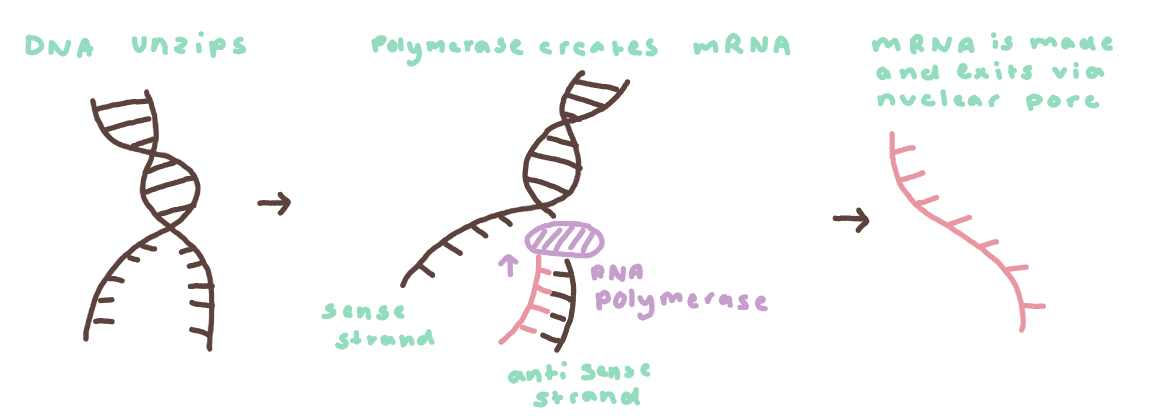
process ends with a messenger RNA (mRNA) strand
mRNA carries genetic info from DNA to ribosomes
✦﹒enzyme-modifications occur in the mRNA transcript
immature mRNA strand becomes mature mRNA after alternate splicing
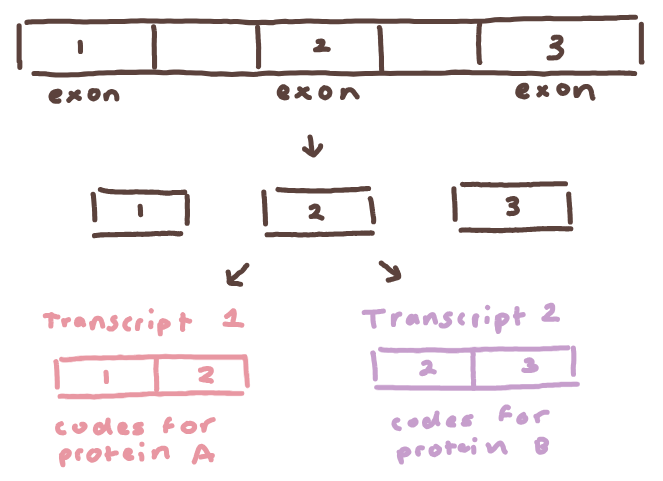
alternate splicing is the process of splicing introns and exons
spliced by the splicisome
introns are a sequence of mRNA transcript that doesn’t code for amino acids
exons are a sequence of mRNA transcript that does code for amino acids
exons can become an intron
alternate splicing enables different transcripts from one mRNA strand
mRNA strand has many diff exons
the different transcripts code for different proteins
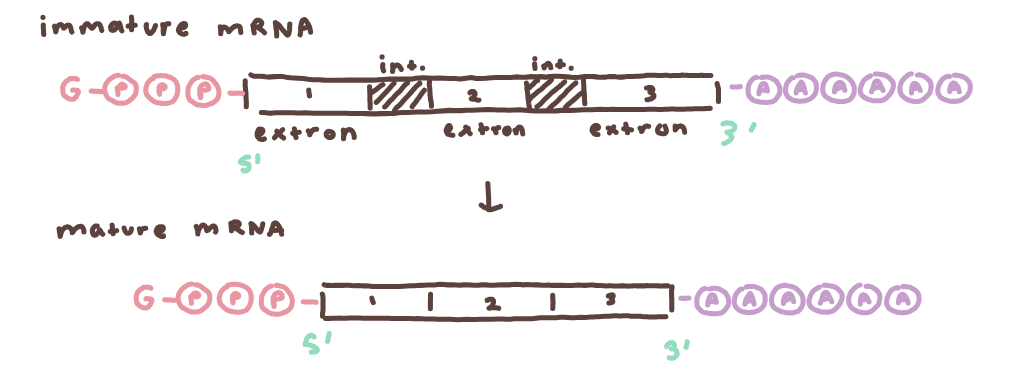
poly-A tail
increases stability, helps export materials
located at 3’ end, with 100-200 adenines
GTC cap
protects transcript and helps ribosome attach to RNA
modified guanine nucleotide at the 5’ end
╭ Other Resources :
:: DNA learning center ﹒﹒ video visual of the transcription process including narration of what is happening
:: DNA learning center﹒﹒ video visual covering alternate splicing
﹙✦﹚﹒besides understanding the process of transcription, understanding the impact and process of alternate splicing is important! also, the function of the poly-A tail and GTC cap. that’s basically everything in this section.
﹙6.4 - Translation﹚
✦﹒translation is the process of generating polypeptides using the info carried on a mRNA molecule
occurs in ribosomes
3 steps— initiation, elongation, and termination
✦﹒initiation is where rRNA in ribosomes interacts with mRNA at START codon
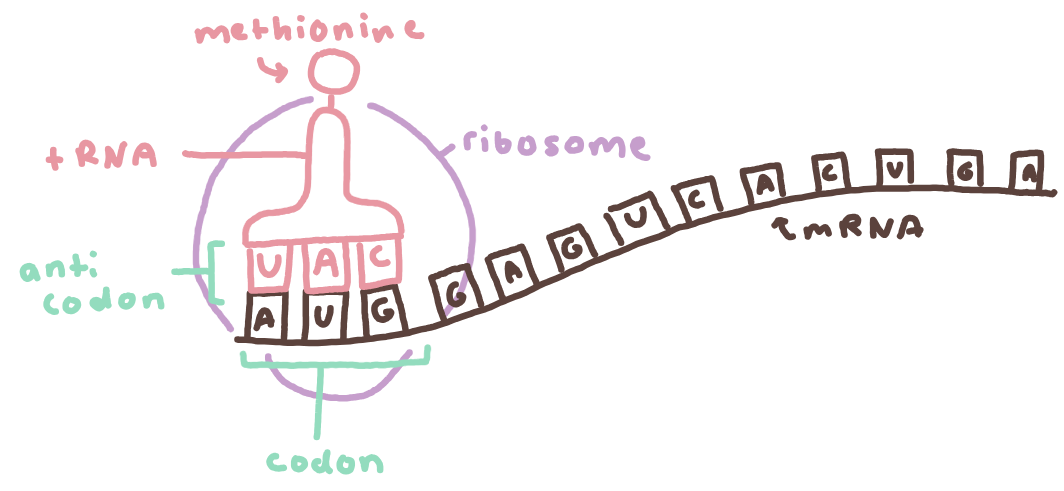
refer to the codon chart
start codon is methionine (AUG)
rRNA (ribosomal RNA) are functional units of ribosome response for protein assembly
pairs codons and anti codons to create amino acids
✦﹒elongation is where tRNA brings amino acids as rRNA connects the chain
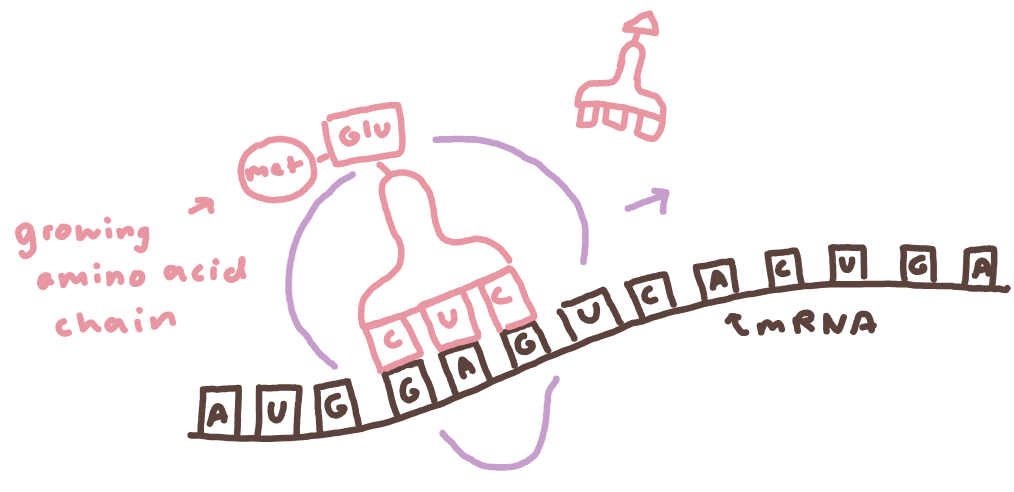
tRNA (transfer RNA) helps create a polypeptide sequence by its complementary anti codon
floats around in cytoplasm
✦﹒termination is where the STOP codon is reached and the process ends
polypeptide chain of amino acids is complete
in prokaryotes, translation occurs at the same time as transcription
✦﹒retrovirus does translation differently
RNA of retrovirus → DNA in host cell → RNA in host cell →Proteins
virus introduces viral RNA into host cells
reverse transcriptase is a viral enzyme that copies viral RNA to viral DNA
that viral DNA is integrated to host genome
nearly ALL organisms use the same genetic code; this is evidence of common ancestry
╭ Other Resources :
:: amoeba sisters ﹒﹒ this video covers translation (3:54) AND transcription (2:43), as well as introducing the codon chart (6:08)
:: DNA learning center ﹒﹒ video visual of the translation process including narration of what is happening
﹙6.5 + 6.6 - Gene Expression ﹚
✦﹒gene expression is the process where DNA is transcribed and translated into a functional protein
different types of chemical reactions help regulate this!
phenotype is determined by combo of expressed genes
✦﹒regulatory proteins are used to assist the promotion/inhibition of protein synthesis
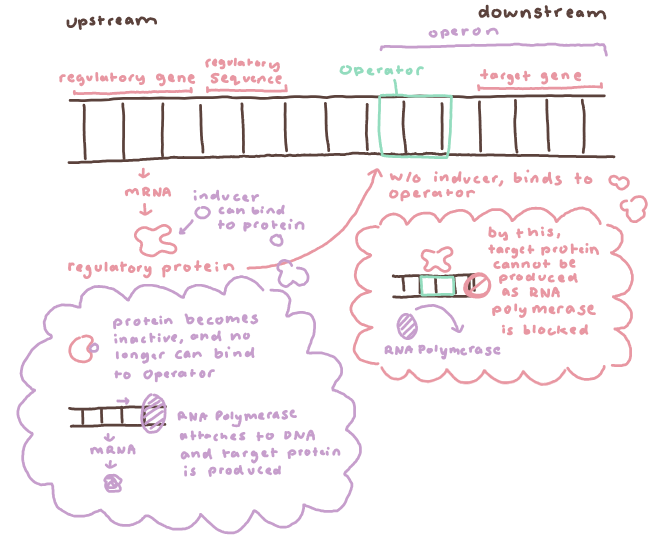 visual of gene regulation | not included— promoter, which is the site RNA polymerase binds to
visual of gene regulation | not included— promoter, which is the site RNA polymerase binds to
interacts w/regulatory sequences due to the presence of transcription factors/modifications of DNA or histones (epigenetics)
sequence consists of operons, closely linked genes that produce mRNA molecules in transcription
operons are like a on/off switch, blocks or induces transcription of particular gene
operons consist of structural/target genes (which codes for the protein that can be blocked/induced) and the operator
regulatory genes controls expression gene at the same time; creates regulatory proteins
✦﹒promoters are sequences upstream of the transcription start site where RNA polymerase and transcriptase factors bind to initiate transcription
this interaction helps determine phenotype differences between tissues within an organism or between organisms
these differences are due to combination of genes that are expressed
✦﹒negative regulatory molecules inhibit gene expression by finding DNA and blocking transcription
small RNA molecules can regulate gene expression post termination by either blocking transcription or by breaking down mRNA
╭ Other Resources :
:: amoeba sisters ﹒﹒ old video discussing gene regulation
:: bozeman science ﹒﹒ 10 minute in-depth video on gene regulation, this includes talking about the lac operon!!
:: professor dave explains ﹒﹒ 13 minute video explaining the regulation of gene expression!
﹙✦﹚﹒this is the concept that will require the most brain power, so do understand it! you could have a deeper level of understanding by referring to an example like the lac operon
﹙6.7 - Mutations﹚
✦﹒mutations are a change in the genome of an organism
they have positive (beneficial), negative (detrimental), or neutral effects on the protein and phenotype that is expressed by the protein
positive if the change encodes a new protein that is beneficial to the organism
negative if the change encodes a new protein that harms the organism
neutral if the change does not change the coding for the intended protein
there are many types of gene mutations—
substitution is where one base is replaced with a different base
impact can be silent, in which the mutation does not change the coding of the intended protein (amino acid sequence DOES NOT change)
deletion is where one base is deleted from the sequence
this can cause a frameshift, in which the ENTIRE sequence after that base is moved and impacted
insertion is where one base of inserted into the sequence
also causes a frameshift
mutations are caused by errors in replication or repair, radiation, or chemical exposure
✦﹒horizontal transfer of genetic info involves exchangement of genetic info between different genomes or unrelated organisms
primarily occurs in prokaryotes
types of horizontal transfer—
transformation is the uptake of “naked” DNA from the external environment
naked DNA is DNA that is not protected by molecules
in biotechnology, bacterial transformation is used to where bacterial cells are primed to uptake foreign DNA by scientists
used to make medicines, modify food, or amplify DNA
transduction is the transmission of foreign DNA into a cell when a viral genome integrates with the host genome
conjugation is cell-to-cell transfer of DNA
comes from contact of the prokaryotes’ pili
╭ Other Resources :
:: amoeba sisters ﹒﹒ 7 min video on mutations!
:: bozeman science ﹒﹒ also a 7 min video (10 seconds longer) on mutations :)
:: FDA ﹒﹒ animation on conjugation, transduction, and transformation
﹙6.8 - Biotechnology﹚
✦﹒gel electrophoresis separates molecules according to size and charge
smaller particles move farther than larger particles
DNA is negatively charged, it goes towards the positive end of the gel
the pattern of these bands (RFLPs) helps identify people in comparison to things
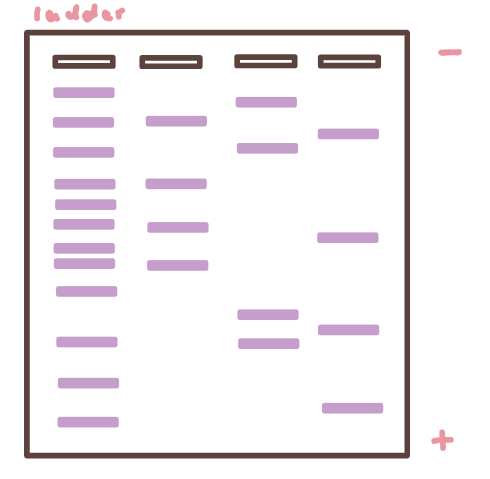
✦﹒polymerase chain reaction (PCR) amplifies DNA fragments
this technique allows for scientists to create large samples of DNA to analyze when small samples are initially available
amplify = copy, PCR is like a copy machine
PCR involves several steps—
DNA is denatured (denaturation)
this is done by the increase of temperature
Primers are added (annealing)
DNA is replicated as primers create complementary strands (extension)
process repeats until enough of the wanted DNA segment is made
╭ Other Resources :
:: amoeba sisters ﹒﹒ video covering PCR
:: amoeba sisters ﹒﹒ video covering gel electrophoresis
﹙✦﹚﹒just note that I didn’t include bacterial transformation in this section because it fitted better in the part discussing transformation in prokaryotes above
 Knowt
Knowt
